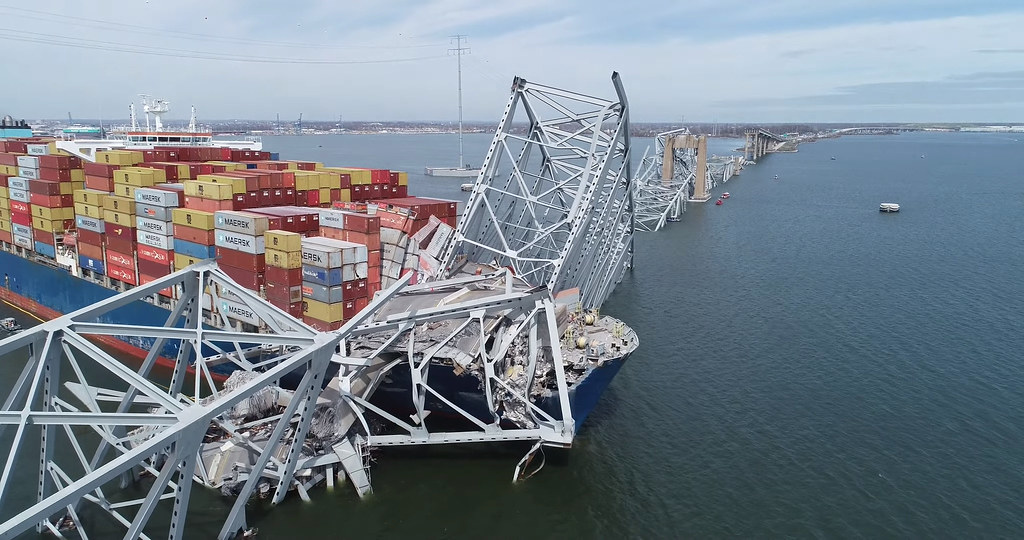On Tuesday, March 26, at about 1:30 a.m., a cargo ship about to pass under Baltimore’s Francis Scott Key Bridge lost power, causing it to collide with one of the bridge piers. “Collide” is probably the wrong word; a better word might be “obliterate.” The bridge collapsed almost instantly, and the ship even continued to move until it was eventually stopped by debris falling on and around it. Although highway patrol did have enough notice to halt traffic onto the bridge, the road crew fixing potholes on the bridge deck were tragically not notified in time, leading to six deaths among the crew.
As a civil engineering student, I’ve been asked a few times by my classmates, friends and family to weigh in on this disaster. The most common question they ask is “could the bridge have been designed differently in order to prevent this disaster?” Well, let’s do some analysis.
Pundits have discussed the use of structural “dolphins”—basically, structures near piers that can redirect or stop ships. But this specific ship was traveling directly toward the pier, so it’s likely that the ship would have bolted straight through a hypothetical dolphin. There’s also the simple fact that the ship is absolutely gigantic. Let me put it this way: The boat was traveling at about nine miles per hour when it hit the pier, and yet it was carrying more than half the kinetic energy of a fully loaded passenger jet at cruising speed. If you were to look at an aerial view of the collision, you’d see that the bridge never stood a chance, nor would almost any bridge.
Now, it’s certainly possible to design for this type of collision. Add concrete dolphins, make the pier thicker, add more piers and so on. But we can’t necessarily predict where the next ship will be—it’d be shortsighted to make just the next bridge over the Patapsco River ship-proof; we’d want to do the same to every other bridge at risk of collision. And who would pay for those costs? As it is, every infrastructure project on the scale of a new bridge has to fight tooth and nail to get properly funded; how would these new, ship-proof bridges ever break ground?
Thus, we’ve reached the defining trait of civil engineering. There are exceptions, but in general, there is no such thing as an impossible civil engineering challenge. There are only challenges worth solving, challenges not worth solving and challenges that you can circumvent. I remember being shocked when I first learned this from my structural engineering professor. When he was talking about designing for forces from wind, he didn’t talk about the worst possible hurricane; instead he talked about designing for, say, a 50-year storm, a hypothetical storm likely to be the strongest in the range of any given 50 years. Estimating design requirements is not a question of possibilities, but rather it’s a question of probabilities.
But why can’t we design for the worst-case scenario? Well, this phenomenon exists in all types of engineering, but it’s especially important in civil engineering. What sets apart civil engineering from other fields is scale and magnitude. Whereas other types of engineers use metal alloys and specialized polymers, we design with concrete and steel, the most used materials in the world. A small difference in widely accepted design makes a massive difference in the amount of resources the planet uses and the money we spend.
The sheer scale of civil engineering is sometimes hard to explain to others. Here’s an amusing little anecdote: Once I talked to a professional engineer in roadway construction, and she brought up the COVID-19 pandemic. She told me that when some of her friends remarked at the time that shelter-in-place meant that the roads could finally get fixed, she had to laugh. She told me, “It’s not about inconveniencing drivers, or even about logistics. It’s about funding, funding, funding.” It’s hard to describe the breathtaking amount of work and money that goes into the dozens of overpasses you drive under every morning. Or, as my structural engineering professor said, if we were to design for the worst possible storm, we’d all be living in underground bunkers. And who’d pay for that?
Some people might look down on this trait of civil engineering. Other engineering students definitely like to joke about civil engineering being the most boring type of engineering. And on its face, I get it; calculating how much reinforcement steel a concrete beam needs is not quite as glamorous as using cutting-edge materials to minimize the weight of a rocket frame. But personally, I prefer the constraint of a budget and politics over the constraint of a mass-to-fuel ratio. It incentivizes us to come up with solutions that minimize our budget while strictly meeting code requirements. More importantly, it keeps us accountable to the public and gives us an interest in politics and ethics.
Speaking of ethics, it’s tragic that this bridge collapse happened. The economic fallout has already interfered with the jobs of thousands of dockworkers in Baltimore, and the six deaths among the road crew should not and cannot be ignored. But if another disaster like this is to be prevented, it will not be with structural dolphins and thicker concrete. It will be prevented by improved safety inspections and power redundancies on cargo ships, or it will not be prevented at all.


